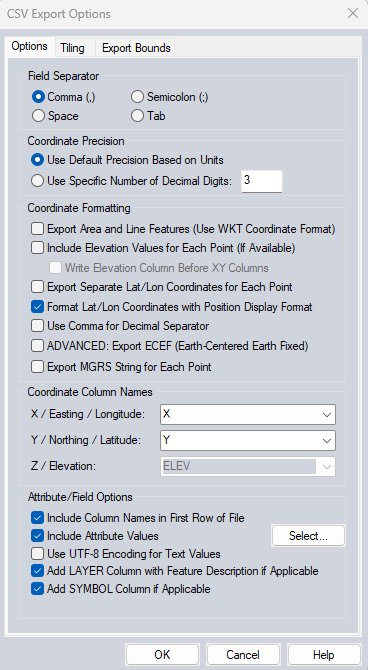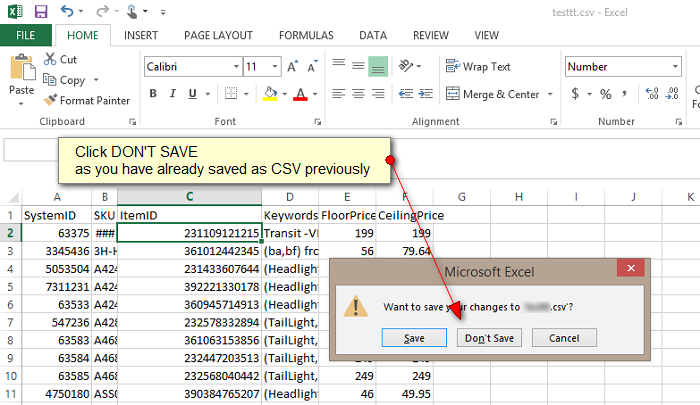

'create the query and it is ready to export 'default the query name to the input name and " text" SqlCmd = sqlCmd & betweenFields & "Format(.)" SqlCmd = sqlCmd & betweenFields & " """""""" &. 'Add each field to the single column being selected 'Create an SQL string to create a single text column with the comma seperated values Set tblQryIn = db.OpenRecordset(tblOrQryName, dbOpenDynaset) 'The quotes have been added to the column of text defined in the query.ĭim sqlCmd, betweenFields, qout As String 'The query can be exported as a CSV with no text delimiters. 'Creates a query that may be exported to allow for real values with precision past two decimal places Public Function FormatForExport(tblOrQryName As String) The result leaves the numerics to be interpretted as numeric as the file is imported. The following function creates the desired query which can then be exported as a comma (or other delimiter) file without text qualifiers. This included qualifying the text columns with quotes. I had the same problem with the export and took RichMorrison's approach of creating a query based on the table to be exported and formatting each column as needed. Hope this helps - glad to hear there's somebody else out there using "real" numbers with lots of decimals! This leaves decimal places intact, but obviously it's not very elegant. The other (quicker, dirtier, bodge job) method that I use is to export first into Excel and from there to text. One disadvantage of this approach is that your numeric field is then treated as text, so you then get quotes around the exported numbers, and if you use the option not to enclose text in quotes, then any actual text fields you export in the same query lose their quotes too.a problem for me at the time (but not necessarily for you), which brings me to method 2 -Ģ.

Save this query (export doesn't work on it otherwise) and export the query instead of the table. Select Format(Fieldname,"0000.00000") AS FormattedField Format the troublesome column by using the format function (credit to Pat Hartman for showing me this one a year ago): Create a query selecting all the records from your table. However, I use 2 solutions, depending on the circumstances:ġ. You can look back on the instructions for prepping your data sheet, and using the filter to clean it up as well.I have come across this exact problem before! As far as I can see it is a "feature" of Access, and you can't solve it by setting table properties. At this point, don’t forget that you’ll still need to do some error checking. This way the formula will get removed, so your importer will be able to understand the values.ħ. In the pop-up, select “Number” in the left category options, change the decimal place to zero, and click “OK”. One way you can fix this is by highlighting the UPC’s column, right click and select “Format Cells”. One thing to note that might happen, is your UPC’s will most likely change during this conversion process. You now need to “Save As” and change the file extension to CSV and save.Ħ. At this point, you’ll notice at the top of the screen it still will have the txt file extension, even though it’s opened in Excel. You’ll then see the Excel sheet fill up as a completed CSV.ĥ. On the next step, leave everything on default, and click “Finish”.Ĥ.
#Easy csv editor change decimal places mac#
On the next screen, under “Delimiters”, uncheck the default selection (which is usually “Tab”), and select “Other:” and enter the Pipe symbol in the box (“|” on your keyboard, usually shift +, on some MAC keyboards it will be to the left of the return key.) then click “Next”.Ĭ. Check “Delimited” for the file type description, then click “Next”.ī. Next, you’ll see a Text Import Wizard pop-up. Then select your file, and click “Open”.ģ. If you don’t see your file listed, make sure that the file extension is broadened to show “All Files”.

Navigate to the txt file you are looking to convert. If you have a newer version of Excel, simply click on “File” in the upper left-hand corner, and “Open”.Ģ. If you have an older version of Excel, click on the office button in the upper left-hand corner, then click on “Open”: Firstly, you’ll need to open a new blank Excel document, then open the txt file in that new document.


 0 kommentar(er)
0 kommentar(er)
